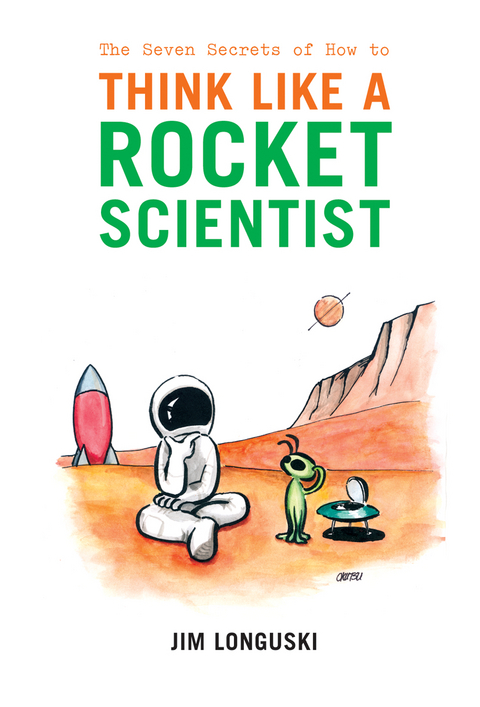
The Seven Secrets of How to Think Like a Rocket Scientist
Springer-Verlag New York Inc.
978-1-4419-2159-8 (ISBN)
This book is a must read for everyone—not just those who think they want to know how Rocket Scientists think.
Explains the methods that rocket scientists use—expressed in a way that could be applied in everyday life. The book illustrates the methods (the 7 secrets) with anecdotes, quotations and biographical sketches of famous scientists, ideas from sci-fi, personal stories and insights, and occasionally a bit of space history. The author reveals that rocket science is just common sense applied to the extraordinarily uncommon environment of outer space and that rocket scientists are people, too.
PRAISE FOR BOOK
It’s really great!—Dr. Buzz Aldrin, Lunar Module Pilot, First Manned Landing on the Moon
"People of Earth…Attention!" Jim Longuski's book takes you on a journey of exploration to that nearly infinite space between the ears and behind the brows of that most mysterious of all creatures—the rocket scientist! Going well beyond the oft-used aphorisms, where no writer has gone before, he shows you how these gifted individuals think, feel, work, play, fantasize, rationalize, laugh and cry. From the glories of their epoch-making achievements to the tragedies of their magnificent failures, it is all here, told with insight, humor, objectivity and personal perspective. Without being preachy, lessons are offered that apply to anyone seeking to make professional or personal life just a little bit more successful and fun. I just couldn't set this book down!—Robert Cesarone, Rocket Scientist, Voyager Navigator, Space Communications Architect
This book is a must read for everyone—not just those who think they want to know how Rocket Scientists think. Do not be scared off by the title; it’s a delightful and wonderfully useful easy read.—Dr. William J. O’Neil, Galileo Project Manager, 1990-1998, Jet Propulsion Laboratory, California Institute of Technology
After receiving his Ph.D. in Aerospace Engineering from The University of Michigan in 1979, Jim Longuski (long-gus´-ske) worked at the Jet Propulsion Laboratory as a Maneuver Analyst and as a Mission Designer. In 1988 he joined the faculty of the School of Aeronautics & Astronautics at Purdue University in West Lafayette, Indiana where he teaches courses in dynamics, aerospace optimization, and spacecraft design. He is coinventor of a "Method for Velocity Precision Pointing in Spin-Stabilized Spacecraft or Rockets" and is an Associate Fellow of the American Institute of Aeronautics and Astronautics (AIAA). Professor Longuski has published over one hundred and fifty conference and journal papers in the general area of astrodynamics including such topics as spacecraft dynamics and control, reentry theory, mission design, space trajectory optimization, and a new test of General Relativity. In 2004, AIAA published Professor Longuski’s first book, Advice to Rocket Scientists: A Career Survival Guide for Scientists and Engineers.
Dream.- Imagine It.- Work on the Big Picture.- Aim High.- BS!.- Brainstorm.- Create Desire.- Tell a Story.- Sleep on It.- Think JFK.- Judge.- Get Real.- Play Games.- Simulate It.- Run a Thought Experiment.- Know Your Limits.- Weigh Ideas.- Ask.- Ask Dumb Questions.- Ask Big Questions.- Ask “What If?”.- Ask: “Animal, Vegetable, or Mineral?”.- Ask Just One More Question.- Check.- Prove Yourself Wrong.- Inspect for Defects.- Have a Backup Plan.- Do a Sanity Test.- Check Your Arithmetic.- Know the Risks.- Question Your Assumptions.- Simplify.- Keep It Simple, Stupid.- Draw a Picture.- Make a Mock-up.- Name the Beasts.- Look at the Little Picture.- Do the Math.- Apply Occam’s Razor.- Optimize.- Minimize the Cost.- Minimize the Time.- Be Mr. Spock.- Make It Faster, Better, Cheaper (But Not All Three!).- Know When Bigger Is Better.- Let Form Follow Function.- Pick the Best People.- Make Small Improvements.- Do.- Learn by Doing.- Sharpen Your Axe.- Correct It on the Way.- Do Something.- Don’t Ignore Trends.- Work on Your Average Performance.- Look Behind You.- Learn from Your Mistakes.- Epilogue.
| Zusatzinfo | 8 Illustrations, black and white; X, 174 p. 8 illus. |
|---|---|
| Verlagsort | New York, NY |
| Sprache | englisch |
| Maße | 155 x 235 mm |
| Themenwelt | Sachbuch/Ratgeber ► Natur / Technik ► Weltraum / Astronomie |
| Naturwissenschaften ► Physik / Astronomie ► Astronomie / Astrophysik | |
| Technik ► Fahrzeugbau / Schiffbau | |
| Technik ► Luft- / Raumfahrttechnik | |
| Technik ► Maschinenbau | |
| ISBN-10 | 1-4419-2159-1 / 1441921591 |
| ISBN-13 | 978-1-4419-2159-8 / 9781441921598 |
| Zustand | Neuware |
| Haben Sie eine Frage zum Produkt? |
aus dem Bereich


